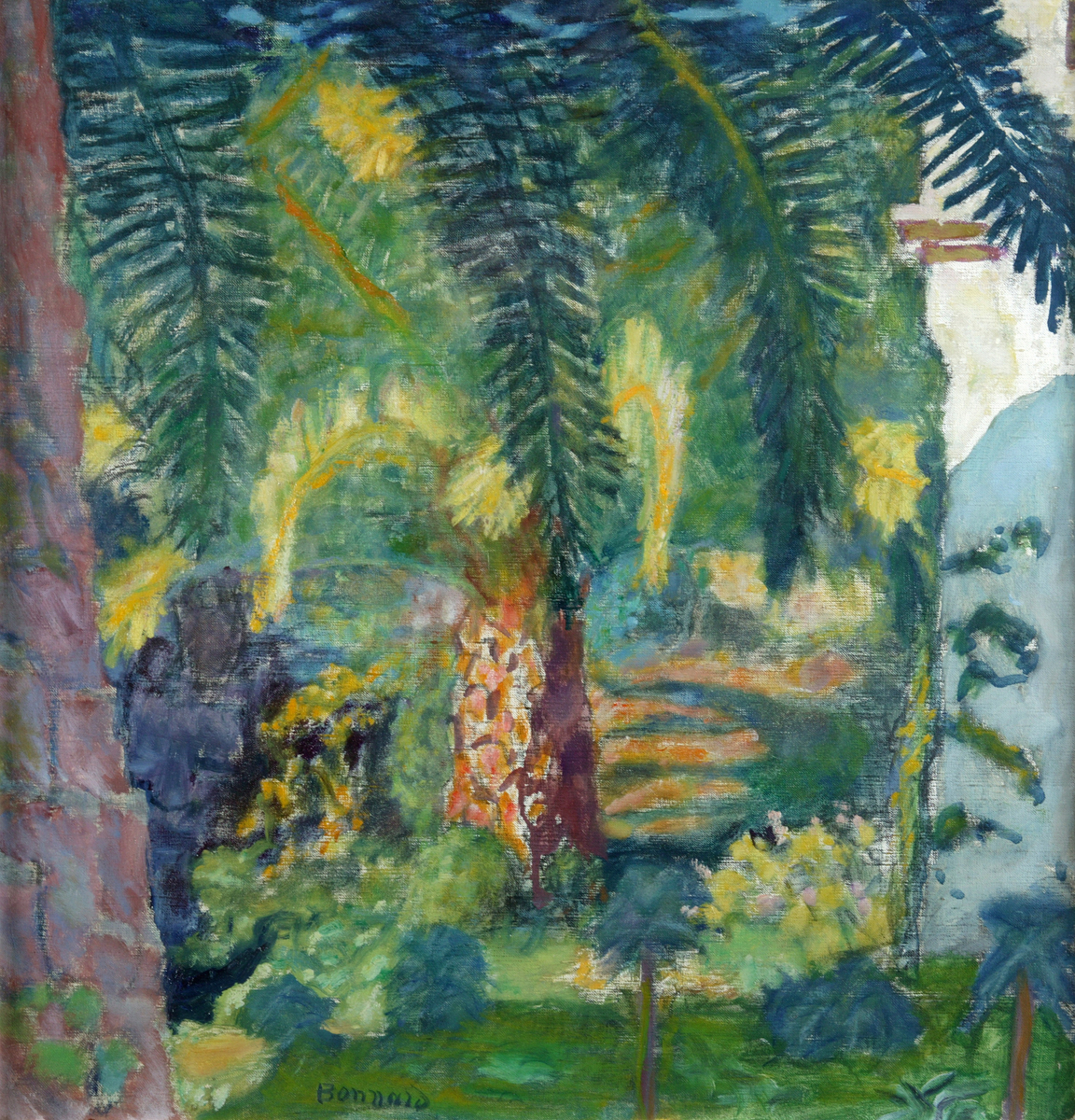Palm Trees at Le Cannet
Summary
A view of a sunlit Mediterranean garden, seen from beneath the leaves of a palm tree, whose trunk is in the foreground to the left, with a second tree in the centre of the garden, which is surrounded by smaller shrubs and flowers. There is the whitewashed wall of a house on the extreme right. The pattern of strong sunlight on shaded gardens was a popular Impressionist theme as it allowed the painter to explore the effect on the eye of both deep shade and dazzling sunlight in one painting. This painting shows the effect of light on shapes and colours. It recreates the experience of looking at nature in strong sunlight. Where the light is dazzling the objects shimmer and are hard to make out. The darker areas are slightly blurred, reproducing the experience of the eye when suddenly moving from light to shade. Le Cannet is a small village near Cannes in the south of France and was where Bonnard had his home, Villa de Bosquet from 1926 until his death in 1947. This painting is from the start of a great sequence of landscapes he painted of Le Cannet and dates from one of his exploratory trips he took between 1922 and 1926. The gardens and countryside round about became one of his principal subjects. Bonnard is sometimes thought of as the last Impressionist.
Display Label
Channel Crossings English and French Impressionism and Post-Impressionism from the collection of Manchester Art Gallery This display looks at the allure and excitement of French art for a generation of English and Scottish painters emerging from the claustrophobia of late Victorian painting. Breaking with the Classical rigours of the Academy and the Salon, the artists who came to be known as the Impressionists painted naturalistic scenes with loose and quickly applied brushwork to convey the effects of light and the natural colours of shadows which had previously been rendered with blacks and browns. They explored the French countryside where they learned how to paint directly en plein air closely studying the changing effects of the seasons. Making regular visits to or studying in Paris, English and Scottish artists were in turn enthralled by these painterly discoveries. The new method of painting they then applied to the English landscape, to still lifes, portraits and interiors. Painters of the New English Art Club like George Clausen, John Singer Sargent and Philip Wilson Steer combined the subject matter of late Victorian genre scenes with the new style. Works by these artists and others are here shown alongside a few choice examples of French Impressionism from the collection and by the fore-runners of Impressionism; Eugène-Louis Boudin, Charles Daubigny and Johan Jongkind. While the English artists went to France the French painters and their dealers, such as Paul Durand-Ruel, escaped the Franco-Prussian war of 1870-71 and went to London. Their paintings were seen in England and some were even bought by Manchester collectors. In the Edwardian era newer developments in French art inspired English and Scottish artists on their cross-Channel trips and via a series of influential London exhibitions. The high-keyed colour and bold lines of the Post-Impressionist paintings of Paul Gauguin and Vincent Van Gogh were now huge influences on the artists of the Camden Town Group such as Harold Gilman and Charles Ginner. Later still Matthew Smith was to take his inspiration directly from Henri Matisse under whom he studied in Paris.
Object Name
Palm Trees at Le Cannet
Creators Name
Date Created
1924 (circa)
Dimensions
canvas: 50cm x 48cm
frame: 67.2cm x 65.1cm
accession number
1987.137
Place of creation
France
Support
canvas
Medium
oil paint
Credit
Purchased with the assistance of the Victoria & Albert Museum Purchase Grant Fund, 1987.
Legal
© ADAGP, Paris and DACS, London 2009

